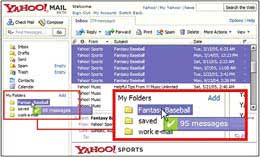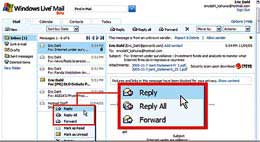 The new “drag-and-drop” feature has made organizing emails in Yahoo Mail, as well as many other email applications based on AJAX technology, much easier.
The new “drag-and-drop” feature has made organizing emails in Yahoo Mail, as well as many other email applications based on AJAX technology, much easier.
This is also the goal of leading webmail service providers like Microsoft and Yahoo, as they strive to make their email services more powerful with upgraded features that provide a user interface increasingly similar to desktop email applications.
In this article, we will overview the new webmail services—most of which are still in testing—including Windows Live Mail and Yahoo Mail, along with a newcomer in the webmail field, Zimbra, an open-source webmail application.
One notable aspect is that all these email service applications utilize AJAX technology, which is becoming increasingly popular to enhance functionality and service quality.
The application of AJAX technology allows these services to preload information and update directly on the display page. Therefore, whenever a user opens an email, they can immediately see its content rather than waiting for the entire webpage to load. Alternatively, if a user wants to delete an email, they will instantly see that the email has been deleted, even while the delete request is still being processed on the server. These are some of the standout features that AJAX brings to the table.
Yahoo Mail

Yahoo Mail has added several new features to make its service more user-friendly and accessible, similar to desktop email applications. This includes support for hotkeys and the use of and keys to select multiple emails simultaneously. Users can also utilize the key to navigate their Inbox more quickly. Although still in testing, Yahoo Mail has become quite robust with a layout divided into three panels, reminiscent of Microsoft’s Outlook Express or Mozilla’s Thunderbird.
Additionally, Yahoo Mail has introduced another handy feature, akin to many other web browsers, that allows users to open multiple emails at once in a single window and switch between them quickly without waiting for a new page to load.
The search functionality in Yahoo Mail has also seen significant improvements, allowing searches within attachments and displaying clearly the segments of text where Yahoo Mail has found the search keywords.
Windows Live Mail

Microsoft’s Windows Live Mail operates similarly to Outlook, integrating hotkey combinations and right-click context menus. If users are not particularly familiar with desktop email applications, Windows Live Mail—which is essentially a completely new version of Hotmail rather than an entirely new webmail service—might be very suitable for them.
Like Yahoo Mail, Live Mail allows users to “drag-and-drop” emails and activate right-click context menus for printing, forwarding, or replying to emails without needing to open them. Live Mail emphasizes tools that allow users to add emoticons and format their emails attractively, as well as integrate a calendar application and stronger spam and phishing protection.
Zimbra
The open-source webmail service Zimbra, while still lacking polish in its interface and having minor bugs in this testing version, boasts impressive search and antivirus features. The calendar functionality of Zimbra is also quite remarkable; users can simply hover over a particular date to see their schedule for that day.
However, Zimbra’s true strength lies in its communication server, which allows companies to integrate their databases, enabling users to access any email with a specific identifier within that database.
Currently, Zimbra does not provide personal email accounts, offering services only to businesses, but some broadband providers, such as Speakeasy, have expressed intentions to implement Zimbra.


















































